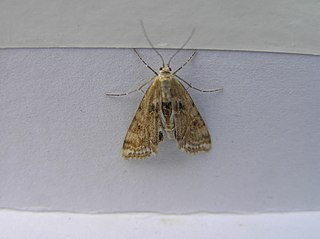| Pseudacrobasis | |
|---|---|
| Scientific classification | |
| Kingdom: | Animalia |
| Phylum: | Arthropoda |
| Class: | Insecta |
| Order: | Lepidoptera |
| Family: | Pyralidae |
| Tribe: | Phycitini Roesler, 1975 [1] |
| Genus: | Pseudacrobasis |
Pseudacrobasis is a genus of snout moths.
| Pseudacrobasis | |
|---|---|
| Scientific classification | |
| Kingdom: | Animalia |
| Phylum: | Arthropoda |
| Class: | Insecta |
| Order: | Lepidoptera |
| Family: | Pyralidae |
| Tribe: | Phycitini Roesler, 1975 [1] |
| Genus: | Pseudacrobasis |
Pseudacrobasis is a genus of snout moths.

The Pyraloidea are a moth superfamily containing about 16,000 described species worldwide, and probably at least as many more remain to be described. They are generally fairly small moths, and as such, they have been traditionally associated with the paraphyletic Microlepidoptera.

The mint moth is a small moth from the family Crambidae, also known by the common name Small Purple and Gold.

Cataclysta lemnata, the small china-mark, is a moth species of the family Crambidae. It is found in Europe, Morocco and Iran.

Nymphula nitidulata, the beautiful china-mark, is a species of moth of the family Crambidae described by Johann Siegfried Hufnagel in 1767. It is found in Europe, Japan (Hokkaido), Turkey, Armenia, Russia and China.

Schoenobius gigantella is a species of moth of the family Crambidae. It is found in Europe and China.

Elophila nymphaeata, the brown china mark, is a species of moth of the family Crambidae. It was described by Carl Linnaeus in his 1758 10th edition of Systema Naturae. It is found in Europe. The moth is notable as its larva, like most members of the crambid subfamily Acentropinae, is aquatic and has tracheal gills.
Sclerocona is a genus of moths of the family Crambidae. It contains only one species, Sclerocona acutella, which is found from Spain and Sicily north to Great Britain and Denmark and east to Siberia, Japan and China. It is an introduced species in eastern North America.

Parapoynx fluctuosalis is a moth of the family Crambidae. It is a widespread species, known from Africa, India, Sri Lanka, China, Japan, Malaysia, Taiwan, Guam, Hawaii, Fiji, Australia and the Galápagos Islands. It is also an introduced species in Europe, where it has been recorded from Great Britain, the Iberian Peninsula and Sardinia.

Hypsopygia mauritialis is a moth of the family Pyralidae described by Jean Baptiste Boisduval in 1833. It is a widespread species, known from Africa, India, China, Malaysia, Taiwan, Japan, Australia and Hawaii.

Pyralis regalis is a species of snout moth. It is found from most of Europe east to Asia, including China, Cambodia, Myanmar, India, Russia, Korea, Japan and Taiwan.
Pempelia heringii, the pear fruit borer, is a moth of the family Pyralidae found in Japan and China and also reported from Hawaii. Two generations occur per year. Larvae have been reported feeding on apple, pear, and Chinese hawthorn. They feed inside young fruit and eject frass from the entry hole, causing visible damage.
Assara hoeneella is a species of snout moth in the genus Assara. It was described by Roesler in 1965, and is known from China and Japan.
Agriphila aeneociliella, the eastern grass veneer, is a species of moth in the family Crambidae. It is found from Denmark, Poland, Ukraine and Romania through Russia to Manchuria, northern China, Korea and Japan.
Anania luctualis is a species of moth in the family Crambidae. It is found in France, Switzerland, Austria, Italy, Croatia, Bosnia and Herzegovina, Hungary, Slovakia, Romania, Poland, Belarus and Russia. In the east, the range extends to China and Japan.
Catoptria permiacus is a species of moth in the family Crambidae described by Wilhelm Petersen in 1924. It is found in Poland, the Baltic region, Finland, European Russia, the Russian Far East, China, Korea and Japan.
Loxostege turbidalis is a species of moth in the family Crambidae. It was described by Treitschke in 1829. It is found in most of Europe, except Ireland, Great Britain, Norway, the Benelux and the Iberian Peninsula. It has also been recorded from Russia, Turkey, China and Japan.
Acropentias aureus is a moth in the family Crambidae. It was described by Arthur Gardiner Butler in 1878. It is found in Japan, China, Taiwan and the Russian Far East.
Sinibotys butleri is a snout moth in the subfamily Pyraustinae in the family Crambidae. It was described in the genus Crocidophora by Richard South in 1901 based on a single female imago collected in Ningbo in China's Zhejiang province. The species is sexually dimorphic, with females exhibiting shorter, less pointed forewings than the males. The imagines and genitalia of the species are illustrated in Lee et al. (2018).
Patissa fulvosparsa is a moth in the family Crambidae. It was described by Arthur Gardiner Butler in 1881. It is found in China, Taiwan, Japan, Korea, India and Indonesia.
Omiodes tristrialis is a moth in the family Crambidae. It was described by Otto Vasilievich Bremer in 1864. It is found in the Russian Far East (Amur), China, Taiwan and Japan.
| This Phycitini-related article is a stub. You can help Wikipedia by expanding it. |